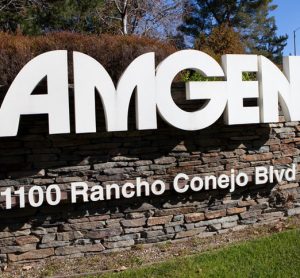The Lancet Oncology publishes results of XGEVA® (denosumab)
Posted: 16 July 2013 | | No comments yet
Phase 2 study reports safety and efficacy results in patients with giant cell tumor of bone…


Amgen (NASDAQ:AMGN) today announced the Lancet Oncology published planned interim results from an international, open-label, Phase 2 clinical trial that is evaluating XGEVA® (denosumab) in adults and skeletally mature adolescents diagnosed with giant cell tumor of bone (GCTB). The study’s primary endpoint is the safety profile of XGEVA. Secondary endpoints are the time to disease progression and the proportion of patients without any surgery at six months.
Based on the investigators’ interim assessment, 96 percent (163/169) of patients with surgically unsalvageable GCTB had no disease progression after a median follow-up of 13 months. In those with salvageable GCTB whose surgery was associated with severe morbidity, 74 percent (74/100) of patients required no surgery, and 62 percent (16/26) of patients who had surgery underwent a less morbid procedure than planned. Overall, 72 percent of patients had objective tumor response, per protocol defined criteria, including 25 percent of patients who had an objective tumor response according to modified RECIST(Response Evaluation Criteria In Solid Tumors).
The overall safety profile was found to be consistent with the known safety profile of XGEVA in patients with advanced cancer. Osteonecrosis of the jaw was reported in one percent (3/281) of patients. Hypocalcemia adverse events, all non-serious, were reported in five percent (15/281) of patients. The most common severe adverse events were low phosphate levels, back pain, pain in extremity, depression, musculoskeletal pain and anemia. Serious adverse events were reported in nine percent (25/281) of patients. No treatment-related deaths were reported.
“These results demonstrate the effectiveness of XGEVA in the treatment of giant cell tumor of bone and reinforce our understanding of this rare disease in which RANK Ligand plays a central role,” said Sean E. Harper, M.D., executive vice president of Research and Development at Amgen. “XGEVA represents a much needed treatment option for patients who suffer from giant cell tumor of bone that can’t be adequately treated with surgery.”
GCTB is a rare, osteolytic tumor of the bone that often results in complete destruction of the affected bone, leading to bone fracture, joint dysfunction, deformity or amputation. GCTB typically affects individuals between the ages of 20 to 40.
XGEVA was approved June 13, 2013 by the U.S. Food and Drug Administration (FDA) for the treatment of adults and skeletally mature adolescents with GCTB that is unresectable or where surgical resection is likely to result in severe morbidity. The approval followed a priority review by the FDA, a designation reserved for drugs that offer major advances in treatment, or provide a treatment where no adequate therapy exists. Prior to approval, there had been no approved therapies for GCTB. Surgery is the main treatment option for patients with resectable GCTB. This study is one of two clinical trials on which the FDA approval was based.
XGEVA is a fully human monoclonal antibody that binds to RANK Ligand (RANKL), a protein essential for the formation, function and survival of osteoclasts – the cells responsible for bone resorption. Giant cell tumors of bone consist of stromal cells expressing RANKL and osteoclast-like giant cells expressing RANK receptor. Signaling through the RANK receptor contributes to osteolysis and tumor growth. XGEVA prevents RANKL from activating its receptor, RANK, on the surface of osteoclasts, their precursors and osteoclast-like giant cells.
Study Design
In this international, open-label, Phase 2 study, 282 patients with confirmed GCTB and measurable, active disease were divided into three cohorts: patients with surgically unsalvageable GCTB (Cohort 1), patients with salvageable GCTB whose surgery was associated with severe morbidity (Cohort 2), or patients who transferred from a previous XGEVA GCTB study (Cohort 3). All three cohorts received subcutaneous XGEVA 120 mg every four weeks with loading doses on days eight and 15. The primary endpoint is the safety profile of XGEVA in terms of adverse events and laboratory abnormalities. Secondary endpoints of the study vary by cohort and include time to disease progression and the proportion of patients without any surgery at six months.
About Giant Cell Tumor of Bone
GCTB is a locally aggressive, benign tumor primarily afflicting younger adults between the ages 20 to 40.1,2 It is estimated that there are approximately 300 to 800 new cases of GCTB annually in the U.S. GCTB is unresectable in approximately 18 to 20 percent of cases.3
Most GCTB tumors occur in the long bones of the body, often around joints, but can also spread to the lungs in rare cases.4,5 Although giant cell tumors are slow growing, patients can experience severe bone pain, soft tissue and joint swelling, loss of mobility and pathologic fracture.4,5 Historically, there have been no approved therapies for GCTB. Surgery is the main treatment option for patients with resectable GCTB; however, surgery, such as amputation, may be associated with significant morbidity.1 These tumors also have a higher recurrence rate within the first three years of surgical intervention.1 When tumors recur, they become more difficult to treat and more likely to spread to other parts of the body.1
About XGEVA
XGEVA was approved by the FDA for the prevention of skeletal-related events (SREs) in patients with bone metastases from solid tumors in 2010. XGEVA is not indicated for the prevention of SREs in patients with multiple myeloma. In clinical trials, XGEVA demonstrated a clinically meaningful improvement compared to the previous standard of care in preventing these bone complications.
In 2013, XGEVA was approved by the FDA as the first-and-only treatment for adults and skeletally mature adolescents with GCTB that is unresectable or where surgical resection is likely to result in severe morbidity.




